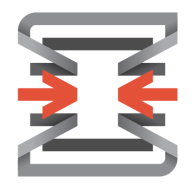


OPNsense and Check Point NGFW compete in the firewall solutions category. Check Point NGFW takes the lead due to its robust security features, appealing to businesses prioritizing comprehensive protection.
Features: OPNsense offers open-source flexibility, packet filtering, and VPN capabilities, along with a variety of plugins enhancing its system. In contrast, Check Point NGFW provides advanced threat prevention, application control, and robust cloud security integration, making it well-suited for businesses needing extensive security measures.
Room for Improvement: OPNsense could expand its customer support and simplify the setup process for less experienced users. Additionally, improving plugin management could add value. Check Point NGFW might benefit from a simpler interface for novice users. Enhanced scalability features and reduced complexity in initial deployment would further improve user experience.
Ease of Deployment and Customer Service: OPNsense is straightforward for those experienced with open-source platforms, though it generally requires self-support. Check Point NGFW, though more complex in setup, provides extensive customer support and technical assistance, making it advantageous for organizations needing guided support.
Pricing and ROI: OPNsense offers low setup costs, appealing to budget-conscious businesses with a focus on ROI. Check Point NGFW has a higher initial cost but justifies pricing through robust security and long-term benefits, making it a strong choice for enterprises prioritizing security over cost.



Fortinet FortiGate offers comprehensive network security and firewall protection across multiple locations. It effectively manages data traffic and secures environments with features like VPN, intrusion prevention, and UTM controls.
Organizations rely on Fortinet FortiGate for its robust integration with advanced security policies, ensuring significant protection for enterprises, cloud environments, and educational sectors. It facilitates network segmentation, application-level security, and authentication management, securing communication within and between locations such as branches and data centers. Its efficient SD-WAN and UTM features enable streamlined data management and enhanced threat protection capabilities. Users appreciate its centralized management, facilitating seamless operations across diverse environments.
What are the key features of Fortinet FortiGate?
What benefits should users expect from Fortinet FortiGate?
Fortinet FortiGate is crucial in sectors like education, offering robust networks for secure data flow between campuses and facilitating remote learning. In enterprise environments, it allows efficient management of application traffic and security across multiple branches, while in the cloud, it seamlessly integrates with diverse platforms to enhance security infrastructure.
Check Point NGFW provides comprehensive firewall protection, managing VPNs, and securing network perimeters with advanced threat prevention techniques. It's widely used to protect businesses, data centers, and ensure secure traffic management.
Check Point NGFW offers robust security for companies, delivering security features like threat prevention, URL filtering, and intrusion prevention across both layer 3 and layer 7. It supports remote access, web filtering, application control, and safeguards against malware, botnets, and zero-day attacks. With its intuitive management console, deep packet inspection, centralized management capabilities, and sophisticated threat detection, Check Point NGFW enhances network security and productivity. The system integrates seamlessly with other technologies and provides real-time monitoring, detailed reporting, and automated policy management. Additionally, its setup is straightforward, it scales well, and offers comprehensive logging.
What are the key features?Check Point NGFW is implemented in industries like finance, healthcare, and retail, where protecting sensitive data and ensuring compliance are critical. Its advanced security features and ease of management make it suitable for large enterprises and data centers, ensuring reliable and secure network operations.
OPNsense is widely used for firewall functionalities, intrusion detection, VPN and IPSec, content filtering, securing network traffic, and remote access. It protects internal networks and manages servers securely, suitable for small to medium-sized businesses.
OPNsense is a comprehensive firewall solution leveraging open-source technology. It integrates with third-party modules like WireGuard and CrowdSec, enhancing its security capabilities. Offering on-premises and cloud deployment, it features an intuitive graphical interface, advanced reporting, VPN functionality, IDS/IPS features, and high scalability. Users find it ideal for small businesses and home networks due to its stability and ease of use. Frequent updates and an active community support its continuous improvement. However, it needs advancements in VPN selection, scalability, and technical documentation. Enhanced high availability, threat intelligence, and integration with virtualization platforms are required. User feedback suggests improvements in connectivity, alerting, traffic monitoring, and antivirus protection.
What are the key features of OPNsense?OPNsense is implemented across various industries to secure network infrastructure and ensure reliable connectivity. In fintech, it safeguards sensitive financial data while maintaining compliance. Educational institutions deploy it to protect student information and enable secure remote learning environments. Healthcare organizations use it to secure patient data and comply with HIPAA regulations. By integrating with tools like WireGuard and CrowdSec, businesses enhance their cybersecurity posture and streamline network management, making OPNsense a versatile choice for diverse operational needs.
We monitor all Firewalls reviews to prevent fraudulent reviews and keep review quality high. We do not post reviews by company employees or direct competitors. We validate each review for authenticity via cross-reference with LinkedIn, and personal follow-up with the reviewer when necessary.